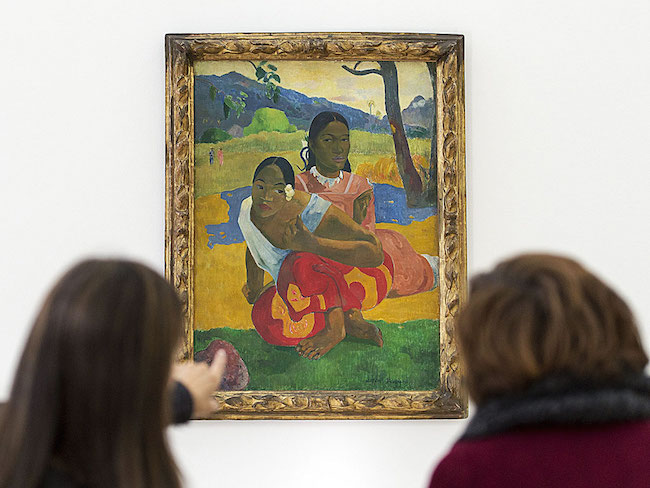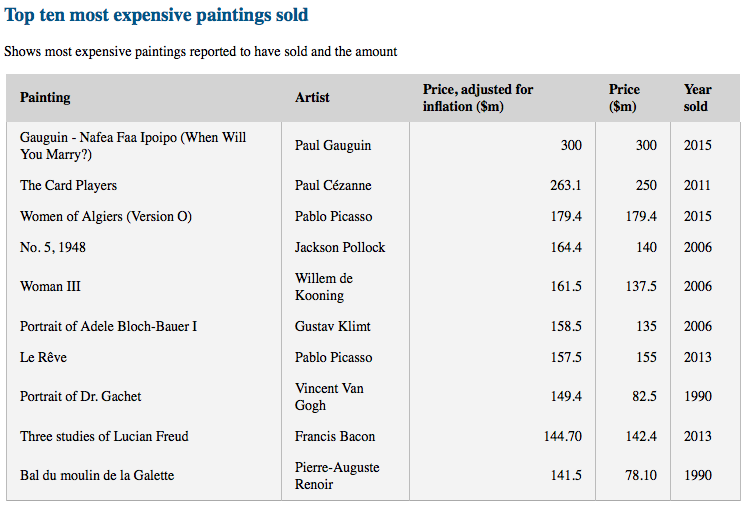Is The Global Art Market Another Massive Multi-decade Fraud?
The Global ART Market: Mother Of All Bubbles
Largest Art Market Transactions Are Conducted With Utmost Secrecy For Very ‘Good’ Reason
by Art Historians For Fair Markets
Very few understand the inner workings of the global art market. Those few who do understand it are insiders who push the buttons and pull the levers behind the curtain.
The institutional arrangements which comprise the world’s high-end art marketplace have been fastidiously put into place over many centuries. It is the playground of the ultra-rich and powerful, well-connected and corporate cronies.
Therefore, one is compelled to ask: Why would extremely wise and knowledgeable investors purchase fantastically overpriced paintings just before the art market bubble is ready to pop?
The recent buying (and selling) spree of high-end artwork makes absolutely no sense at all unless the market is completely rigged … just like the stock market … the commodities market, the currency markets, the derivatives market, etc., etc, etc.
Long before there were any of these other financial instrument exchanges there was art, perhaps one of the oldest means of exchange. Consequently, the art market has been around so long that it is quite easy for those who control it to manipulate it ANY WAY THEY WANT TO.
There are two HUGE factors which have undermined the Art Market over many decades.
#1 There are now countless numbers of fake and fabricated pieces of high-end art work in the marketplace
#2 The real prices actually paid, for the most exorbitantly priced pieces of art, cannot be substantiated because of strict confidentiality clauses and rules
These two ongoing market dynamics have served to cordon off the entire high-end art market from all but a few billionaires and institutional investors. However, even in these cases the buyer must rely on the expertise and integrity of those very experts who can legitimately authenticate a nearly 300 million dollar Gauguin painting. Just how many art authorities are there in the world who can competently identify an original painting from an impressionist or old world master?
Especially in a technologically sophisticated environment is it becoming more and more difficult to spot the fakes. Counterfeit paintings, manufactured sculptures and the like have always been around, except that now there are many more of them, and they are much higher quality. Some of the bogus art is even more convincing than the originals.
As for point #2, all of the highest priced art transactions are conducted with the utmost secrecy — for quite obvious reasons — and, therefore, cannot be corroborated. Many of the largest transactions have clauses of the strictest confidentiality built into the sales contract which effectively eliminate the possibility of tracking down the legitimacy of the purchase. Some have even surmised that some of these hundred million dollar transactions have not even taken place and that they are nothing but a sham conducted to artificially manipulate art prices upwards … as in “through the proverbial roof”.
When one considers exactly what pieces have been sold over the past few years for prices that are as inconceivable as that are preposterous, the prevailing climate begs for further investigation.
After all, who in their right mind would pay such astronomical prices for pieces of decaying artwork which cost tremendous amounts to adequately insure, properly house, safely transport and correctly maintain?
Biggest Auction Houses: Classic Example Of the Fox Guarding The Hen House
Let’s face it, just like the New York Stock Exchange (NYSE), both Sotheby’s and Christie’s function as the clearing house (and brokerage firm) for a vast majority of the world’s highest priced art transactions. The very fact that they can serve in both capacities — clearing house and brokerage firm — at the same time, creates ample opportunity for the fox to take advantage of the hens. In each case these auction houses, of ‘sterling’ repute, (hmm, sounds like the British pound) are completely owned and operated by the same characters who have a substantial interest in fixing the game.
What game?
When a Gauguin sells for almost $300 million, it permits every art dealer and art gallery owner in the world to blow that horn. In this way, not only is every Paul Gauguin painting immediately inflated (many say artificially) in price, so are all the impressionist paintings of the last two centuries.
One can see very easily how this game really works — on raw emotion and fictitious sales hype, and with no validation of the largest transactions which occur in an effectively clandestine ‘marketplace’. That’s because there really is no marketplace; just a group of privileged insiders exchanging their artwork for prices real or imagine or otherwise, since no one can substantiate them … ever.
Now take a good look a these prices for the TOP TEN most expensive paintings ever sold publicly.
What savvy art investor or whimsical billionaire would ever pay such prices for an old artifact with forever-fading oil colors or water colors on canvas?
Particularly in the case of the more modern artists do these obviously unwarranted prices make NO sense at all; unless of course, they were meant to rev up the marketplace. It really only takes one or two outrageous sales to completely skew the pricing for an entire segment of the art market.
That two Pablo Picasso paintings would command the number 3 and 7 spots for $179.4 million and $157.5 million, respectively, is particularly suspect. In view of how easy it is to duplicate Picasso’s art, any buyer of his work is really taking a gamble — a HUGE gamble, not too unlike those who are buying way overpriced stocks on the NYSE throughout 2015.
How do you spell S U C K E R ‘S R A L L Y?
Afterthought:
Who would ever really pay $179.4 million for Pablo Picasso’s “The Women of Algiers”? This is nothing more than an old man painting his favorite female body parts … over and over again, while looking through a Coke bottle.



